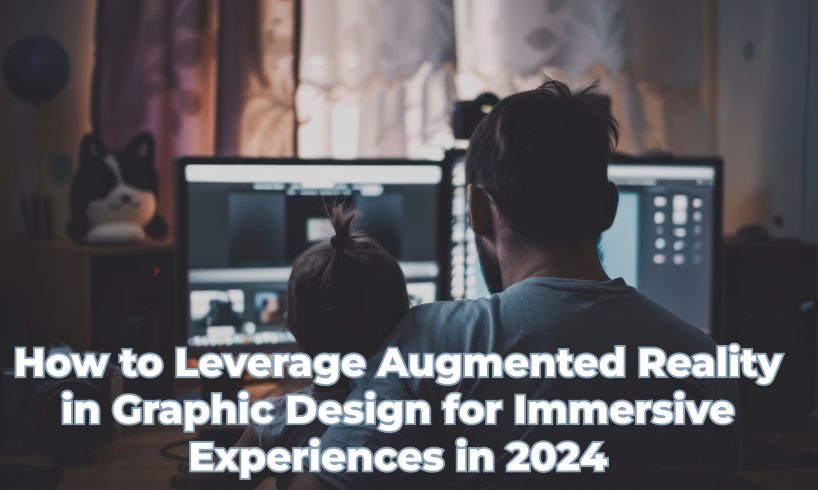
Augmented Reality (AR) has evolved from a futuristic concept to a practical tool, transforming various industries, including graphic design. By integrating AR into your design projects, you can create more engaging and interactive experiences for users. This post explores how to effectively leverage AR in graphic design, ensuring your work stands out in 2024 and beyond.
Understanding Augmented Reality in Graphic Design
Before diving into techniques and strategies, it’s essential to understand what AR is. Augmented Reality overlays digital content—such as images, sounds, and other data—onto the real world, usually through a smartphone or AR glasses. Unlike Virtual Reality (VR), which creates a completely digital environment, AR enhances the existing physical world.
Why AR in Graphic Design?
AR opens up a new dimension of possibilities for graphic designers. Here’s why you should consider incorporating it into your projects:
- Enhanced User Engagement: AR makes designs interactive and engaging, capturing users’ attention more effectively than static images.
- Innovative Storytelling: With AR, you can tell stories in more dynamic ways, blending digital elements with the physical world.
- Increased Brand Awareness: AR experiences can make your designs memorable, helping brands stand out in a crowded market.
- Real-Time Feedback: AR allows for real-time user interaction, providing immediate feedback and data that can inform design improvements.
Practical Applications of AR in Graphic Design
- Interactive Packaging: Imagine a cereal box that, when scanned with a smartphone, reveals a 3D character telling a story or providing nutritional information. This not only enhances the user experience but also adds value to the product.
- Advertising Campaigns: AR can turn a regular poster into a captivating experience. Users can scan the poster with their phone to see animated graphics, videos, or special offers, creating a memorable and interactive advertisement.
- Product Demos: For e-commerce, AR allows customers to visualize products in their real environment. This can be particularly useful for furniture or fashion brands, where seeing the item in context can significantly influence purchasing decisions.
- Educational Materials: AR can bring textbooks to life, making learning more interactive and engaging. Diagrams can transform into 3D models, and historical events can be re-enacted in real-time, providing a richer educational experience.
Steps to Integrate AR into Your Graphic Design Projects
- Conceptualize Your AR Experience
- Identify the Purpose: Determine what you want to achieve with your AR project. Is it to educate, entertain, or sell a product?
- Know Your Audience: Understand who will be using the AR experience and tailor the content to their preferences and technological capabilities.
- Choose the Right Tools
- AR Platforms: Use AR platforms like Adobe Aero, Spark AR, or Unity to create and deploy AR content. These tools offer various features to help you bring your designs to life.
- 3D Modeling Software: For creating 3D assets, software like Blender or Autodesk Maya can be very helpful.
- Design for AR
- User Interface (UI): Ensure the UI is intuitive and user-friendly. The AR experience should be easy to navigate.
- Consistency: Maintain visual consistency between the digital and physical elements to create a seamless experience.
- Interactivity: Incorporate interactive elements that users can engage with, such as touch or voice commands.
- Test and Refine
- Prototyping: Create prototypes to test your AR experiences. This can help identify any usability issues early on.
- User Testing: Conduct user testing to gather feedback and make necessary adjustments. Pay attention to how users interact with the AR elements and make improvements based on their input.
- Deploy and Promote
- App Integration: Decide whether your AR experience will be available through a standalone app or integrated into an existing one.
- Marketing: Promote your AR experience through social media, email campaigns, and other marketing channels to drive engagement.
Challenges and Solutions in AR Graphic Design
- Technical Limitations
- Solution: Stay updated with the latest AR technologies and tools. Regularly upgrade your skills and software to handle the evolving technical requirements.
- User Accessibility
- Solution: Design with accessibility in mind. Ensure that your AR experiences are compatible with various devices and are easy to use for people with different abilities.
- High Development Costs
- Solution: Start with small, manageable projects to demonstrate the value of AR to stakeholders. This can help secure funding for larger projects in the future.
Future Trends in AR and Graphic Design
- AI Integration: Combining AR with artificial intelligence (AI) can lead to more personalized and adaptive user experiences. For instance, AI can analyze user behavior to customize AR content in real-time.
- Wearable AR: With advancements in wearable technology, AR glasses are becoming more mainstream. Designers need to prepare for creating experiences that are optimized for these devices.
- 5G Technology: The rollout of 5G networks will significantly enhance AR experiences by providing faster data transfer and reduced latency, allowing for more complex and interactive designs.
- Sustainability: As awareness of environmental issues grows, there will be a push towards sustainable AR solutions. This includes designing AR experiences that consume less power and resources.
Conclusion
Augmented Reality is reshaping the landscape of graphic design, offering new ways to engage and captivate audiences. By understanding the fundamentals of AR and how to apply it effectively, you can create immersive experiences that stand out in 2024 and beyond. Embrace the challenges, leverage the right tools, and stay ahead of the trends to make the most of this exciting technology.
Incorporating AR into your graphic design projects not only enhances user engagement but also provides innovative ways to tell stories and showcase products. As technology continues to evolve, the possibilities for AR in graphic design are limitless. Start exploring and experimenting with AR today to stay at the forefront of this dynamic field.
Featured Image Credit: Freepik






